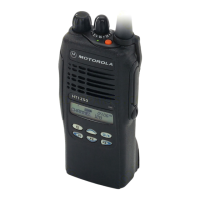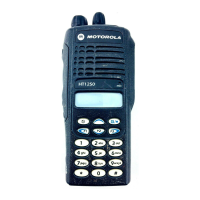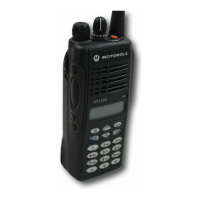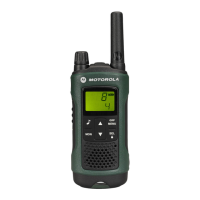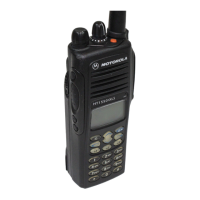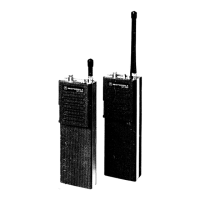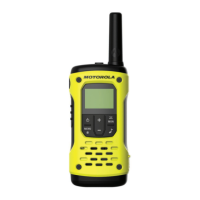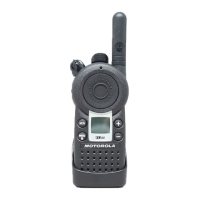7-10 Low Band, 800 MHz, PassPort & 900 MHz Theory of Operation: 800 MHz Receiver
7.7.1 Receiver Front-End
The RF signal is received by the antenna and applied to a low-pass filter. For 800 MHz, the filter
consists of L101, L102, C104, C105, C106, C107, C109. The filtered RF signal is passed through the
antenna switch. The antenna switch circuit consists of two PIN diodes (CR101 and CR102) and a pi
network (C109, L103 and C110).The signal is then applied to a fixed tuned ceramic bandpass filter,
FL300.
The output of the bandpass filter is coupled to the RF amplifier transistor Q302 via C300. The RF
amplifier provides a gain of approximately 12 dB. After being amplified by the RF amplifier, the RF
signal is further filtered by a second fixed tuned ceramic bandpass filter, FL301.
Both the pre and post-RF amplifier ceramic filters have similar responses. The insertion loss of each
filter across the 851–870 MHz band is typically 1.8 dB.
The output of the post-RF amplifier filter is connected to the passive double balanced mixer, U301.
After mixing with the first LO signal from the voltage controlled oscillator (VCO) using low side
injection, the RF signal is down-converted to the 109.65MHZ IF signal for PCB No. 8480641Z02/
8480641Z03 and 73.35MHZ IF signal for PCB No. 8471827L03.
The IF signal coming out of the mixer is transferred to the crystal filter (FL350) through a resistive
pad and a diplexer (C312 and L306). For PCB No. 8480641Z02/8480641Z03, the matching to the
input of the crystal filter is provided by L353,L354, C377, and C378. For PCB 8471827L03_C, the
matching to the input of the crystal filter is provided by C350, C351 and L350. The crystal filter
provides the necessary selectivity and intermodulation protection.
7.7.2 Receiver Back-End (for PCB No. 8480641Z02/8480641Z03)
The output of crystal filter FL350 is matched to the input of the dual gate MOSFET IF amplifier
transistor U352 by components L355, R359 and C376. Voltage supply to the IF amplifier is taken
from the receive 5 volts (R5). AGC voltage is applied to the second gate of U352. The IF amplifier
provides a gain of about 11dB. The amplified IF signal is then coupled into U351(pin 3) via L352,
R356 and C365 which provides the matching for the IF amplifier and U351.
The IF signal applied to pin 3 of U351 is amplified, down-converted, filtered, and demodulated, to
produce the recovered audio at pin 27 of U351. This IF IC is electronically programmable, and the
amount of filtering (which is dependent on the radio channel spacing) is controlled by the
microprocessor. Additional filtering, once externally provided by the conventional ceramic filters, is
replaced by internal filters in the IF module (U351).
The IF IC uses a type of direct conversion process, whereby the externally generated second LO
frequency is divided by two in U351 so that it is very close to the first IF frequency. The IF IC (U351)
synthesizes the second LO and phase-locks the VCO to track the first IF frequency. The second LO
is designed to oscillate at twice the first IF frequency because of the divide-by-two function in the IF
IC.
In the absence of an IF signal, the VCO will “search” for a frequency, or its frequency will vary close
to twice the IF frequency. When an IF signal is received, the VCO will lock onto the IF signal. The
second LO/VCO is a Colpitts oscillator built around transistor Q350. The VCO has a varactor diode,
CR350, to adjust the VCO frequency. The control signal for the varactor is derived from a loop filter
consisting of R365, C391, and C392.
The IF IC (U351) also performs several other functions. It provides a received signal-strength
indicator (RSSI) and a squelch output. The RSSI is a dc voltage monitored by the microprocessor,
and used to control the automatic gain control (AGC) circuit in both the front-end and the IF.
The demodulated signal on pin 27 of U351 is also used for squelch control. The signal is routed to
U404 (ASFIC) where squelch signal shaping and detection takes place. The demodulated audio
signal is also routed to U404 for processing before going to the audio amplifier for amplification.
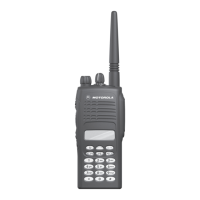
